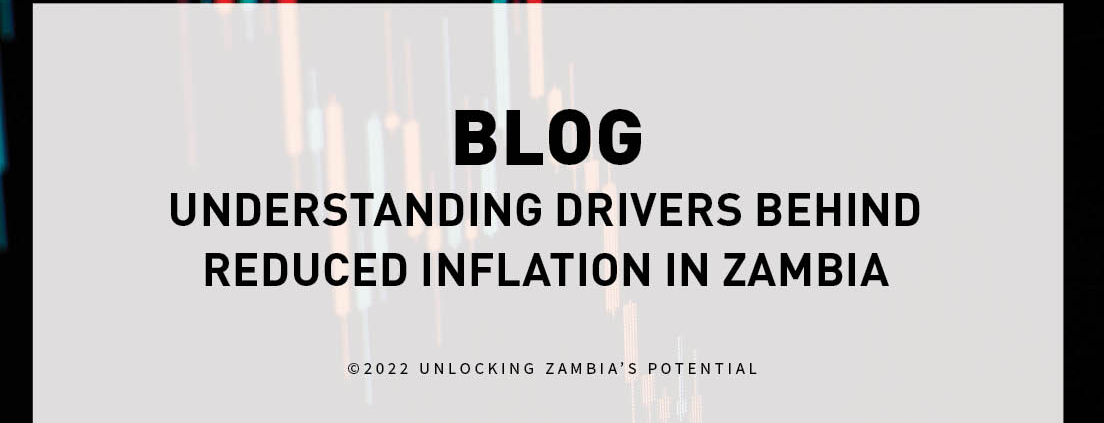By PMRC Researchers – Emmanuel Mumba and Mabvuto Lungu
INTRODUCTION
Over the period 2019 to 2021, inflation in Zambia has been higher than the 6-8 percent target range. Inflation averaged 9.1 percent in 2019, 15.6 percent in 2020 and rose further to an average of 22.1 percent in 2021. Inflation is a broad measure involving goods and services and not only consumer food. It measures the overall impact of price changes for a diversified set of products and services. Calculating the overall inflation rate for a country requires an index with broader coverage of items called basket. Depending on the country and its consumption habits of the majority of the population, the basket will have different goods. Some goods might record a drop-in prices and others may increase and the overall value of inflation will depend on the weight of each of the goods with respect to the whole basket.
In 2019 and 2020, the increase in inflation was mainly attributed to the depreciation of the Kwacha against the trading currencies, and upward adjustments in energy prices (fuel pump prices and electricity tariffs). Upward pressures on food prices following the adverse impact of the 2018/19 drought and trade disruptions, that followed the lockdown measures taken in response to the COVID-19 pandemic in early 2020, also contributed to rising inflation. The higher inflation outturn in 2021, was also associated with a sustained increase in food prices and the depreciation of the Kwacha until the second half of the year. The inflation in Zambia is as a result of price changes on several goods and services. In a hypothetical example, using one of the most consumed items in the country (cooking oil) from the basket for illustration purposes for a period January to April. Suppose the initial price of cooking oil in January is K70 and over the next months, increases to K100, K125, and K135 in February, March and April respectively, the rates at which the price of cooking oil increased from January to April are K30, K25 and K10 respectively as shown below.
K70 K100K125K135 or when expressed in percentage change. The rate at which prices of cooking was increasing from one month to another at a decreasing rate is what is called inflation. Therefore, a reduction in the inflation rate does not mean a reduction in the prices of goods and services but the reduction in the rate at which prices are increasing.
EFFORTS TOWARDS REDUCTION IN INFLATION BY GOVERNMENT
Government has been using a mixture of monetary and fiscal measures to control the rate of inflation towards its aspiration of an inflation rate of between 6-8 percent. Some of the key measures that the Government has been using to control inflation are not limited to the following:
The monetary policy being one of the major tools used by the central bank to control inflation has been instrumental during this period. The Monetary Policy Committee (MPC), at its November 22-23, 2021 Meeting, decided to raise the Monetary Policy Rate by 50 basis points to 9.0 percent. This was done in order to help steer inflation to single digits in 2022 and to within the 6-8 percent target range by mid-2023 as stated in the 2022 Budget Address. As anticipated, a sharp decline was experienced in the inflation rate and during the previous two MPC meetings (in February 2022 and May 2022) the MPC rate has been maintained at 9%.
In the 2022 national budget, the Government initiated a number of reforms to support the agriculture, livestock and fisheries sectors. These included among others, the removal of 5% customs duty on the importation of cattle breeding stock and suspension of 5% customs duty on grandparent and/or parent stock of day-old chicks. These actions and many others have drastically addressed the supply shocks and moderately improved the price movements in food items such as meat. Subsequently arresting food inflation from a whole year high of 31.6 % in August 2021 to 9.7% in June 2022.
The Kwacha has been stable for the past few months in trading against major currencies, which has contributed to a reduction in inflation. In the last three months, the Kwacha has sustainably been on a bullish trend appreciating averagely at 5.8% monthly against the US dollar. This performance has been anchored on enhanced fiscal consolidation measures, positive market sentiments emanating from the progress made on the IMF Extended Credit Facilities with its accompanied debt structuring programme and support from the Central Bank through its open market operations. Other factors that have buoyed up the Kwacha sprung from the encouraging dollar-quoted tax declarations from the mining sector. These factors have unwaveringly reduced the imports value basket for the imports-dependent local manufacturing sector, reducing production costs and thus, moderating consumer price levels.
Government is urged to continue with its fiscal consolidation measures towards achieving a stable single-digit inflation rate which will positively impact the prices of goods and services in the long term. Lastly, in order for the gains of the single digital inflation to be realised and yield economic dividends through the reduction of the cost of living, there is need for continued stability of the exchange rate as well as stable fuel prices which are critical determinants for the cost of goods and services through its impact on the cost of production.




